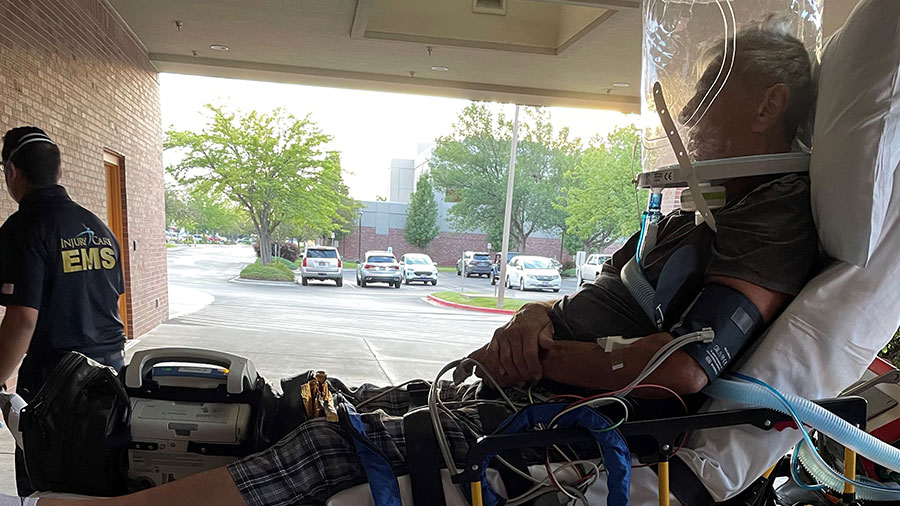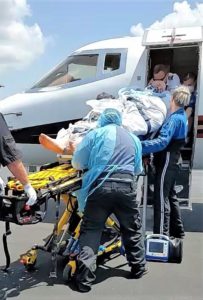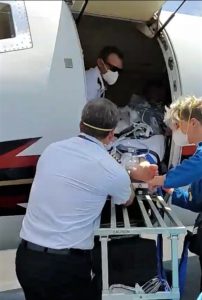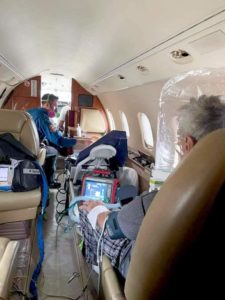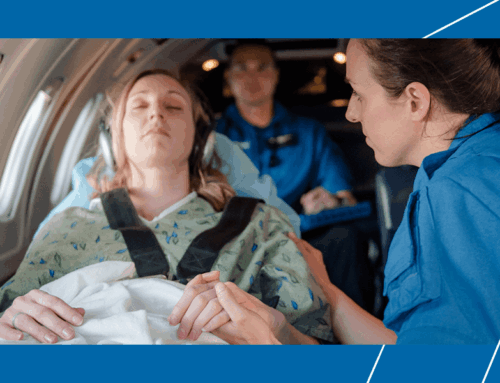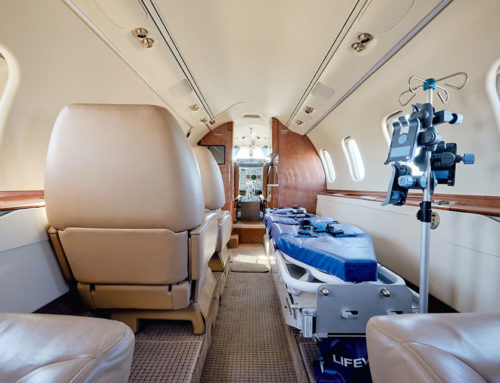AirCARE1 recently provided a case study of two Covid patient transports to the International Travel & Health Insurance Journal (ITIJ), featured in the Air Ambulance Review September 2021 Issue. Read the article below:
CASE STUDY: AirCARE1 Air Ambulance continues to transport Covid patients
Nat Arnold, Flight Paramedic and Client Relations Specialist at AirCARE1, describes how the company is continuing to care for Covid patients

Safety for our crews and protecting them properly is first and foremost the goal of every single Covid flight. We fly in a pressurised cabin at altitudes of 40,000 feet, so our pilots must be able to access their oxygen masks within seconds in the event of a sudden depressurisation. This safety requirement does not allow them to wear N-95 masks. Therefore, we utilise specialised equipment for Covid patients to properly isolate and protect everyone on board. For non-intubated patients, we use the Amron Oxygen Hood or the ISOVAC isolation chamber. For our intubated patients we utilise multiple filters placed within the ventilator circuit. Every mission is centered around safety, from the crew safety perspective to each individual patient care plan.
First patient
An elderly male patient was vacationing alone at his Mexican condo when he became ill. He was seen by a resort physician and subsequently tested positive for Covid-19. The resort physician called multiple facilities within Mexico and was unable to find a hospital bed placement. The patient’s daughter flew down to evaluate and plan the evacuation of her father out of Mexico. Upon arrival, she realised that he was short of breath, required oxygen therapy, and was dehydrated. The daughter obtained an oxygen concentrator and placed the patient on six litres per minute (lpm) of oxygen via nasal canula and began the search for long-range transport to Idaho. Care Plan and equipment selection After the medical team received their report from the daughter it was identified that the patient was awake, alert and ambulatory. It was decided he would be placed in the Amron Oxygen Hood for both isolation and high flow oxygen. The patient was not coming from a healthcare setting, so our team would need to initiate intravenous therapy and administer medication as needed.
Arrival to patient
Transporting US patients out of Mexico is often very challenging; in this case the crew was required to take extra steps and time to provide documentation to the Mexican authorities before being able to receive the patient. When the team finally made patient contact, he was found to be breathing at a very rapid rate, was very weak, and required increasing amounts of oxygen. After an IV was started, the patient was placed in the Amron isolation hood with high flow settings of 60lpm of flow and FI02 of 40 per cent. He was then brought to our Learjet 60 aircraft and secured for flight. While in flight, he received droperidol and Zofran for nausea and sedation. He was administrated an IV bolus and continued with a maintenance IV fluid. With the flight time of three hours, the amount of oxygen our system uses, and the amount the oxygen we carry on the aircraft, we had to pay precise attention and constantly calculate our settings.
Arrival to Idaho
Once landed, the patient was transported by the AirCARE1 medical team via ground ambulance to a local emergency department where a team was awaiting to accept care. The patient improved at the hospital and is expected to make a full recovery. The patient’s family is to be commended for their ingenuity and quick action in getting the patient back to the US for better care before further decompensation.
Second patient
A 38-year-old male with no pertinent past medical history presented to a rural Texas urgent care was treated and admitted to a small hospital. He continued to deteriorate so he was sedated, intubated, and placed on a ventilator after failure to protect his airway and oxygenate. The facility lacked the resources to provide ongoing care. Covid cases have been on the rise in their area so an appropriate bed could not be found within the 30 hospitals across Texas, Louisiana, and Oklahoma. The family assisted in the process and finally found an ICU in Colorado that would accept the patient.
Care Plan
After receiving a full medical report, the AirCARE1 team discussed the patient’s situation in depth. First looking at safety, the patient was on the ventilator with the multiple inline filters present, so the pilots would be safe in the cockpit. Looking at the patient’s fragile vitals, ventilator settings, extended flight time, and further patient condition; the medical crew developed and prepared multiple care options to have on hand when they arrived to collect the patient.
Arrival to patient
When we arrived, the patient’s condition had deteriorated requiring immediate intervention from our team. He needed increased oxygen amounts and other modified ventilator settings. To safely transport him, the crew chose a plan that involved administering additional medications including propofol, versed, fentanyl and rocuronium, and altering the ventilator settings to improve oxygenation while assessing supplied aircraft oxygen. Each move had to be carefully handled to keep the patient’s vitals stable due to his critical state. Hot temperatures and high humidity in Texas were especially difficult for the team to navigate while loading the patient into the aircraft.
Flight and arrival to receiving hospital
Throughout the 2.5-hour flight, the crew continued to make medication and ventilator adjustments that allowed for patient improvement and stability. Upon landing in Colorado, the patient was transported via ambulance to the hospital, and we transferred care to an entire ICU team. The patient sadly remains unstable, on the ventilator, and has developed multiple infections. It is unknown what kind of recovery he will endure.
Pictures from the flight
Click Here to View the Original Article on ITIJ.com
Click Here to View the Original Article in the Digital Issue

